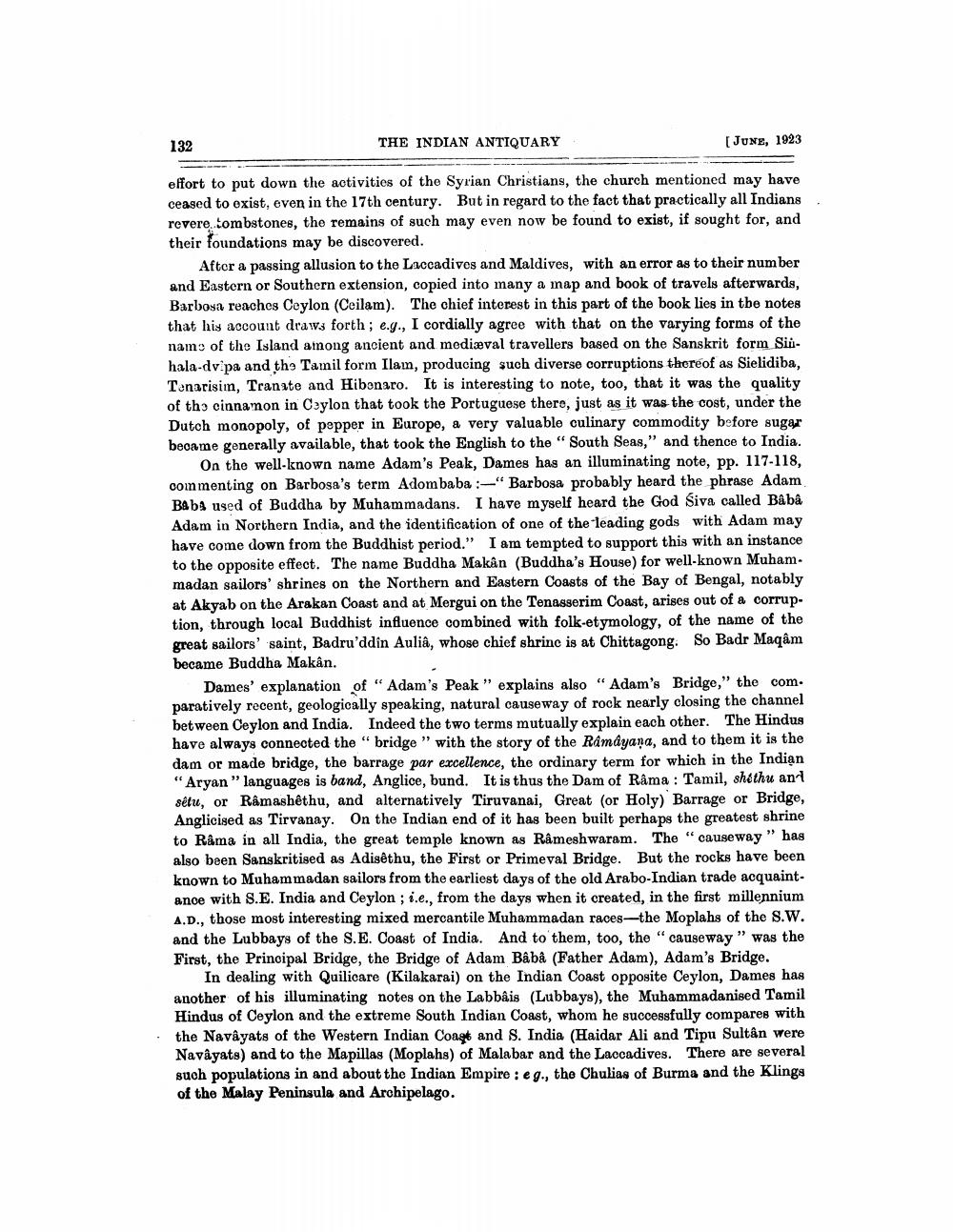________________
132
THE INDIAN ANTIQUARY
[June, 1923
effort to put down the activities of the Syrian Christians, the church mentioned may have ceased to exist, even in the 17th century. But in regard to the fact that practically all Indians revere tombstones, the remains of such may even now be found to exist, if sought for, and their foundations may be discovered.
After a passing allusion to the Laccadives and Maldives, with an error as to their number and Eastern or Southern extension, copied into many a map and book of travels afterwards, Barbosa reaches Ceylon (Ceilam). The chief interest in this part of the book lies in the notes that his account draw forth; e.g., I cordially agree with that on the varying forms of the name of the Island ainong ancient and medieval travellers based on the Sanskrit form Siúhala-dv pa and the Tamil form Ilain, producing such diverse corruptions thereof as Sielidiba, Tonarisim, Tranate and Hibonaro. It is interesting to note, too, that it was the quality of the cinnamon in Ceylon that took the Portuguese there, just as it was the cost, under the Dutch monopoly, of pepper in Europe, a very valuable culinary commodity before sugar became generally available, that took the English to the “ South Seas," and thence to India.
On the well-known name Adam's Peak, Dames has an illuminating note, pp. 117-118, commenting on Barbosa's term Adombaba :-"Barbosa probably heard the phrase Adam Babi used of Buddha by Muhammadans. I have myself heard the God Siva called Bâbâ Adam in Northern India, and the identification of one of the leading gods with Adam may have come down from the Buddhist period." I am tempted to support this with an instance to the opposite effect. The name Buddha Makan (Buddha's House) for well-known Muham. madan sailors' shrines on the Northern and Eastern Coasts of the Bay of Bengal, notably at Akyab on the Arakan Coast and at Mergui on the Tenasserim Coast, arises out of a corruption, through local Buddhist influence combined with folk-etymology, of the name of the great sailors' saint, Badru'ddin Aulia, whose chief shrine is at Chittagong. So Badr Maqam became Buddha Makân.
Dames' explanation of " Adam's Peak" explains also "Adam's Bridge," the com. paratively recent, geologically speaking, natural causeway of rock nearly closing the channel between Ceylon and India. Indeed the two terms mutually explain each other. The Hindus have always connected the “ bridge” with the story of the Ramayana, and to them it is the dam or made bridge, the barrage par excellence, the ordinary term for which in the Indian "Aryan "languages is band, Anglice, bund. It is thus the Dam of Râma : Tamil, shethu ant sétu, or Râmashếthu, and alternatively Tiruvanai, Great (or Holy) Barrage or Bridge, Anglicised as Tirvanay. On the Indian end of it has been built perhaps the greatest shrine to Râma in all India, the great temple known as Rameshwaram. The "causeway " has also been Sanskritised as Adigêthu, the First or Primeval Bridge. But the rocks have been known to Muhammadan sailors from the earliest days of the old Arabo-Indian trade acquaintance with S.E. India and Ceylon ; i.e., from the days when it created, in the first millennium A.D., those most interesting mixed mercantile Muhammadan races—the Moplahs of the S.W. and the Lubbays of the S.E. Coast of India. And to them, too, the "causeway” was the First, the Principal Bridge, the Bridge of Adam Bâbâ (Father Adam), Adam's Bridge.
In dealing with Quilicare (Kilakarai) on the Indian Coast opposite Ceylon, Dames has another of his illuminating notes on the Labbâis (Lubbays), the Muhammadanised Tamil Hindus of Ceylon and the extreme South Indian Coast, whom he successfully compared with the Navâyats of the Western Indian Coast and S. India (Haidar Ali and Tipu Sultân were Navâyats) and to the Mapillas (Moplahs) of Malabar and the Laocadives. There are several such populations in and about the Indian Empire : eg., the Chulias of Burma and the Klings of the Malay Peninsula and Archipelago.




